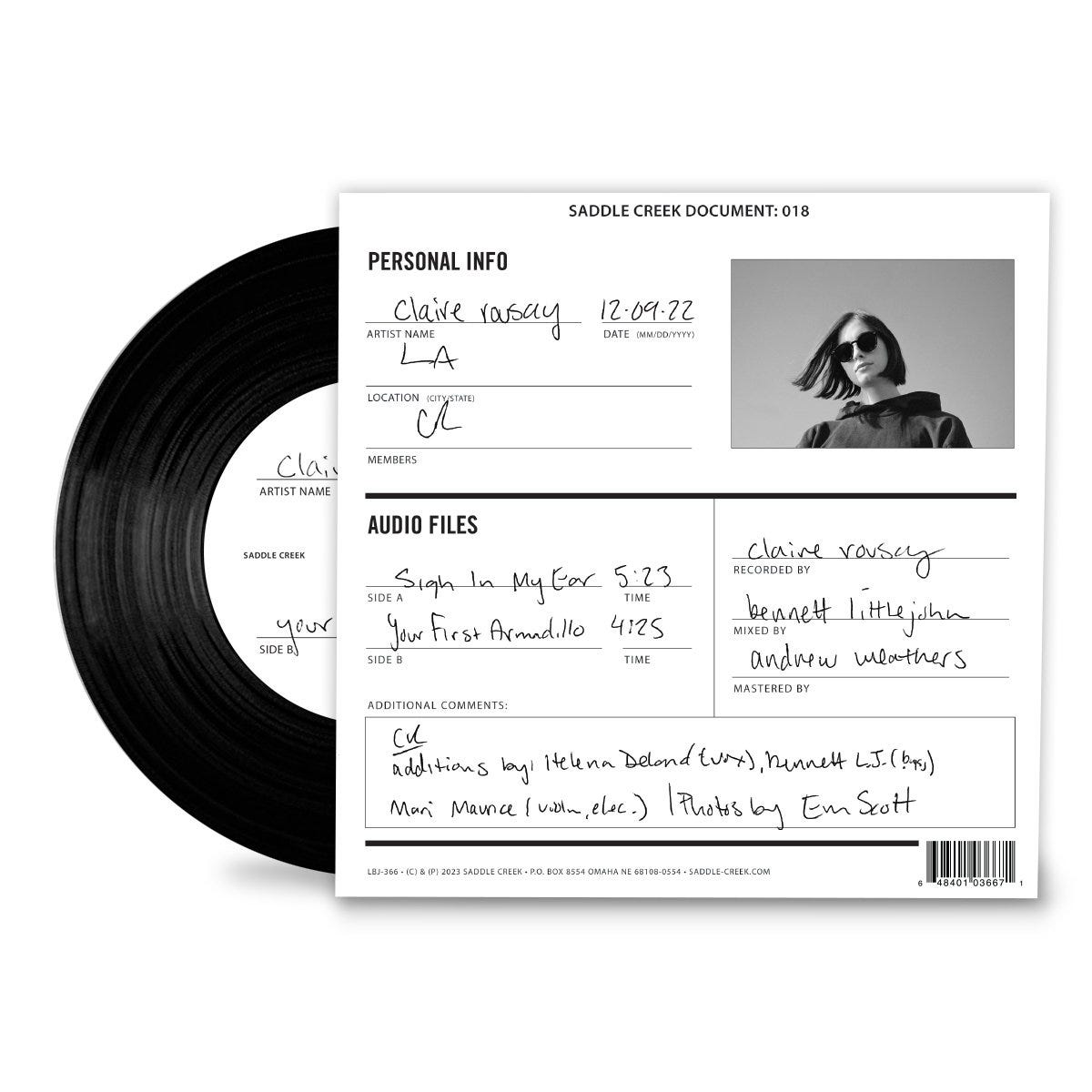OUT OF THE BOX #2
claire rousay ~ Sigh In My Ear (2023)
I began this series with one of the first 7”s I ever bought, so I figured for the second installment I would jump to the most recent.
claire rousay has made a name for herself over the last few years as a sensitive composer of quotidien sentimalism with records on Already Dead Tapes, Longform Editions, American Dream, Orange Milk, Second Editions, and Shelter Press. It was recently announced that she has signed to Thrill Jockey, but not before releasing this 7” on Saddle Creek as part of their Document Series, highlighting work by artists outside their roster.
I don’t know how the economics of this works, but it’s exactly the kind of thing that attracted me to 7”s as a teenager. (Though seven inches certainly didn’t cost $11 back then.) At that time Saddle Creek was one of my favorite labels, home to Bright Eyes, Cursive, Desaparecidos, and The Faint. I had some instagram exchanges with claire about our shared love of Jade Tree Records and Jimmy Eat World, and she’s recently been (half-winkingly) pushing ‘emo ambient’ as a genre, so while her working with Saddle Creek doesn’t exactly come as a surprise, I very much enjoyed the overlap in this particular Venn diagram.
I first encountered her work as the opening track on Free Percussion (2019), tsss tapes’ debut release, a compilation of improvisations by twelve percussionists, including Rie Nakajima, Ted Byrnes, and Will Guthrie. Label head Francesco Covarino made a mix for ACL in early 2020, just before the pandemic, to celebrate the first anniversary of the label. So I already had filed rousay away in my mind as a drummer, even if her releases over the next several years saw her move further away from such a simple description. Her background as a percussionist is often still perceptible, even if it seems she’s less likely to be manipulating a drum kit in favor of small sounds (creaking chairs, rustling in a drawer, crinkling paper, ASMR-style whispers), as part of a larger collage of field recordings, electronic manipulation, speech2text, voice messages and other documents of everyday life.
But that background behind the kit is an important frame. Rhythm is about subdividing time, and since music is a time-based art form, it has long been my view that percussionists often make the most interesting composers. So many of my favorite composers (Steve Reich, Vladislav Delay, Egisto Macchi, Mai Mai Mai) began as drummers. Let’s add rousay to this list. So even when actual percussive instruments are lacking, there is still a compositional approach informed by her experience as a drummer.
Unlike the piece for Free Percussion that introduced me to her work, most of rousay’s music has been the result of careful editing of field recordings, strings, piano, vocals, midi instruments, and a variety of vocals. A particularly effective use of speech2text can be heard on the devastating transmutation of a breakup letter on it was always worth it (Longform Editions, 2020), and in the radical honesty (and humour) of i’m not a bad person but… (Amplify 2020). That combination of heart-on-sleeve emotional openness with awkward self-deprecation captures what I like most about her music, and makes Saddle Creek an oddly fitting home for the two songs on Sigh In My Ear, a title that itself evokes the intimacy so often at the heart of rousay’s music, whatever form it takes.
Sigh In My Ear is something of a departure, if one that makes good sense given the context, but is perhaps better heard as an evolution. 2020’s a heavenly touch (2020) already featured piano, whispers, iPhone texting sound effects, underblowing a flute, and other instruments. Perhaps her earlier work for Already Dead Tapes does as well, I haven’t heard everything. What makes these compositions so appealing is their kaleidoscopic quality, musical collages without rupture but also lacking an obvious throughline. Perhaps it’s too on the nose to say there’s something queer about rousay’s work, but I think the various meanings of the word are apt in this care, that sense of being askew is central to the music itself.
On records such as a softer focus (2021) and everything perfect is already here (2022) traditional instrumentation (piano, strings) took a more guiding role, autotuned vocals, but still with drones, textures, and nuance. The trajectory makes sense, as structure, melody, and vocals gradually become more grounded, experimentation confined more to tone and texture and feel than structure. The “diaristic” quality of her work seemed to become more central during the pandemic, perhaps also embolding her to be more openly vulnerable without the instant feedback of live audiences.
The growing complexity of her sound palette, and also the drift towards more traditional song structures and away from free form improvisation, might be partially attributed to her collaborative works. Her collaborations are as significant as her solo work, which often features contributions from other musicians in any case, including Derek Baron, Alex Cunningham, and many others. Now Am Found (2021) with Patrick Shiroishi saw the two musicians eschewing their usual instruments, while a very busy social life (2022) with the incredible Anne-F Jacques, who coaxes sounds from mundane objects like tubes and simple devices in a kind of analogue version of rousay’s field recordings, are two of my favorites, and each reveal different sides of her practice. But it is if i don’t let myself be happy now then when? (2020) and Never Stop Texting Me (2022) with more eaze (2020) that strikes me as the turning point in rousay’s work, with the former’s title a reference to Jimmy Eat World, the first sign of emo appreciation I picked up on in rousay’s work.
But OK, I didn’t set out for this to a primer, so let’s turn to the 7”. So all that said, these two tracks feel like quite a departure, perhaps less so considering they’ve been released by the label that brought us Bright Eyes and Cursive. “Sigh In My Ear” is a relatively straightforward song, melancholic autotuned vocals sung over strummed guitar. The vocals shift to Helena Deland’s breathy falsetto at 2 minutes as the arrangements build, augmented by tasteful string and piano embellishments. Those arrangements gradually fade away, but at four minutes, just as the song seems to be resolving, a code begins. The full “band” crashes back in, with a rhythmic element for the first time, what I’m pretty sure is the clicking of a turn signal. Not at all out of place within the Saddle Creek stable.
The B-side, “Your First Armadillo” isn’t much brighter, but is a bit looser in structure and is my favorite of the two. The track opens with obscure field recordings, various voices in the distance and car noise, perhaps, generic ambience setting, as sustained electric organ chords slowly swell, accented by a plaintive piano melody. The title evokes rousay’s home state of Texas, and although I’m not sure what an armadillo sounds like (when it’s not screaming), the field recordings use natural sounds (insects? snakes?) as a recurring rhythmic element, against which these beautiful harmonies meander around a repeating descending chord progression. The final minute of the composition reaches a dramatic anticlimax, as elements subtle shift space in the mix, elongating what’s already there rather than crashing back in as in the A-side. The more I listen to this record, the more I’m drawn into “Your First Armadillo.” Again, it’s not uplifting or happy, but there’s something warm and comforting that keeps me coming back.
So we have “emo ambient” or “diaristic ambient,” maybe I’ll add lowercase emo, for rousay’s unassuming style. But genre labels are for lazy journalists and fan’s who don’t want to do the work of discovering music for themselves. rousay’s music continues to evolve, and I’m still getting a kick of seeing world’s collide with this bit of nostalgia for my teen years. I don’t think I’ve paid attention to anything Saddle Creek has released since Bright Eye’s Cassadaga (2007), and while I don’t think this 7” will change that (I never understood the appeal of Two Gallants or Big Thief), it has prompted me to put on Cursive’s Domestica for the first time in a couple years. One of my absolute all-time favorite records that hits just as hard now as it did when I was 16, and in fact the themes hit in a very different way as an adult. But that’s a story for another time.




